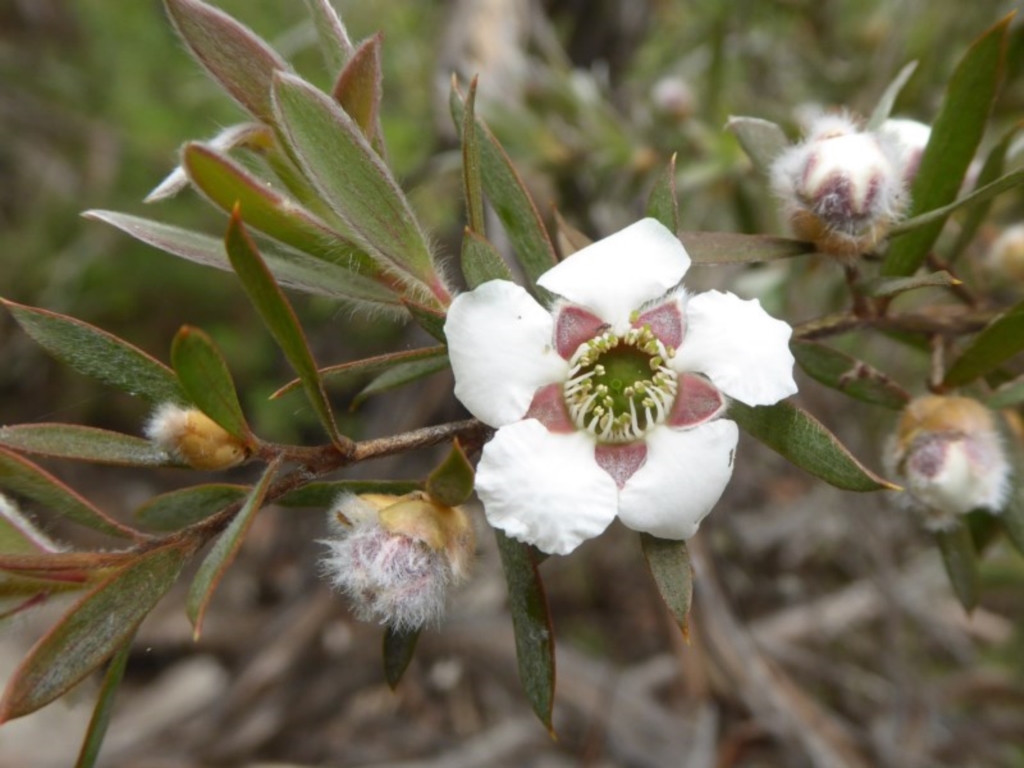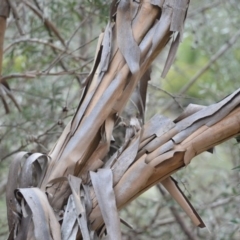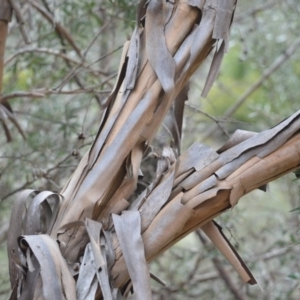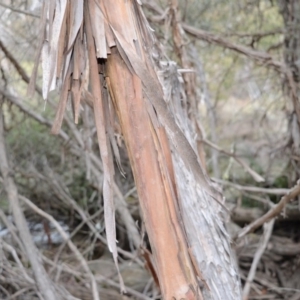Woolly Teatree, Mountain Tea-tree at Bolaro, NSW
Identification history
| Leptospermum grandifolium | 17 Aug 2017 | BettyDonWood | ||
| Leptospermum grandifolium | 17 Aug 2017 | BettyDonWood | ||
| Leptospermum lanigerum | 14 May 2017 | DavidMcKay |
Identify this sighting
Please Login or Register to identify this sighting.
User's notes
Common along the Banks of the Murrumbidgee
13 comments
BettyDonWood
wrote:
15 May 2017
Probably OK, though at that altitude I would have expected Leptospermum grandifolium. A photo of the bark would have helped. Grandifolium has peeling bark, and leaves that are green and often glossy above. Lanigerum has hard rough bark, and grey-green leaves.
DavidMcKay
wrote:
16 May 2017
Thanks for the information and I will check the bark next time I am in the area. I would think that around 1000m would be much in the middle of the range for lanigerum. Is there a good authority for checking this sort of information?
BettyDonWood
wrote:
16 May 2017
Plantnet and Vicflora, both online, are the best, if you are prepared to look up every second word in the glossary, as I did when I first started. I still do for some words, and tear my hair out when there is no definition in either for a few words they think are 'obvious'.
JackieMiles
wrote:
3 Jun 2017
Hi folks, I checked the photo against my shots of both lanigerum and grandifolium and it could be either. The flowers are a dead ringer for my grandifolium flowers, but then lanigerum are very similar. Likewise with the leaves. For some reason I'm not seeing the map, so not sure of the location but in my experience the most obvious difference between the two species is ecological: lanigerum is riparian, i.e on creek and riverbanks, while grandifolium is on gullies within euc forest and around the edges of subalpine bogs at high elevation, i.e around 1000m plus. Not sure about the elevation range for lanigerum - it's certainly on the tablelands, but not sure how high it gets.
DavidMcKay
wrote:
3 Jun 2017
Betty suggested looking at the bark and leaves but it will be late August before I get back to the area to do that. The elevation is just below the 1000m contour and the bushes line the banks of the Murrumbidgee. One specimen is on a tiny island and they are flooded when there is heavy rain like last spring. More photographs of leaves and bark are on my "to do" list along with some of the general environment.
JackieMiles
wrote:
5 Jun 2017
I see Betty's confirmed it as lanigerum, and now that I can see the map, plus your habitat description, I'd agree with that. It can be helpful to include some habitat description in your notes (which you did, but more detail is always better), along with any other species growing with the unknown one, if you recognise any. Often the ecological setting is just as helpful as the appearance in making an ID.
DavidMcKay
wrote:
6 Jun 2017
Hi Jackie. Thanks for the tips. I am still learning about all the info needed for good identification. It has been a good experience and lots of fun.
DavidMcKay
wrote:
17 Aug 2017
Hi Jackie. Did you get the email with new photographs of distinctly peeling bark. I checked the vegetation over a short stretch of the river bank and all had the distinctive peeling bark. This suggests that although it is a riverine environment grandifolium is the correct identification as the main species in this area
JackieMiles
wrote:
18 Aug 2017
No David, I didn't get the photos. You should be able to add them to this record by editing it. Then you'd have to let me know by email to have a look. As I am not a moderator for CNM I don't get emails advising me of new sightings.
DavidMcKay
wrote:
18 Aug 2017
Hi
I have been back to the area and checked the bark which the photographs show clearly peeling in layers even down to pencil thin twigs. I checked a short stretch of the river and all were similar. The leaves are not particularly glossy but they have had the winter season of heavy frost and the odd snowfall. Does this look like the ID should be grandifolium? Possibly this particular environment the favours this species along the river. I appreciate the confusion could have been avoided if I had taken note of the bark at the time. I am learning and now photograph leaves (both sides), bark, flowers, whole plants and the general environment.
I have been back to the area and checked the bark which the photographs show clearly peeling in layers even down to pencil thin twigs. I checked a short stretch of the river and all were similar. The leaves are not particularly glossy but they have had the winter season of heavy frost and the odd snowfall. Does this look like the ID should be grandifolium? Possibly this particular environment the favours this species along the river. I appreciate the confusion could have been avoided if I had taken note of the bark at the time. I am learning and now photograph leaves (both sides), bark, flowers, whole plants and the general environment.
JackieMiles
wrote:
19 Aug 2017
Your bark photos look very like mine of grandifolium, but unfortunately I don't have any bark shots of lanigerum. The NSW Flora doesn't distinguish that well re bark: bark smooth for lanigerum and "bark smooth and exfoliating" for grandifolium. Yours is certainly exfoliating.The Vic Flora is a bit better: smooth for lanigerum and "papery, shedding in strips or flakes" for grandifolium. So I guess despite the riparian habitat you have grandifolium at this location. According to the Vic Flora it grows on watercourses, gullies and sheltered slopes in montane forests. The latter two habitats are the only places I've seen grandifolium so far myself.
DavidMcKay
wrote:
19 Aug 2017
I guess altitude, aspect, rainfall, river or creek banks or swamp all interact to produce the local environment that favours one species or the other. I am glad it now seem nailed as like me there will be others who depend on the photographs and comments to help identify interesting plants
JackieMiles
wrote:
20 Aug 2017
Not that well nailed I suspect. I've seen a shrub growing in heath up in Barren Grounds Nature Reserve west of Kiama that gets called grandifolium and it doesn't look much like the montane one, or have much in common in terms of habitat. Plus there is the variability in leaf hairiness, so I think this group of Leptos needs more work.
Please Login or Register to comment.
Nearby sightings
Location information
- Coordinates 148.794173-35.947042
- Altitude 993.0m
- Places Bolaro, NSW
Sighting information
- 4 - 15 Abundance
- 12 Aug 2017 11:56 AM Recorded on
- DavidMcKay Recorded by
Additional information
- True In flower
- 1 metre to 5 metres Plant height
Species information
- Leptospermum grandifolium Scientific name
- Woolly Teatree, Mountain Tea-tree Common name
- Not Sensitive
- Local native
- Non-Invasive
- Up to 1652.17m Recorded at altitude
- Machine learning
-
In flower
- External link More information
Record quality
- Images or audio
- More than one media file
- Confirmed by an expert moderator
- Nearby sighting(s) of same species
- GPS evidence of location
- Description
- Additional attributes















































